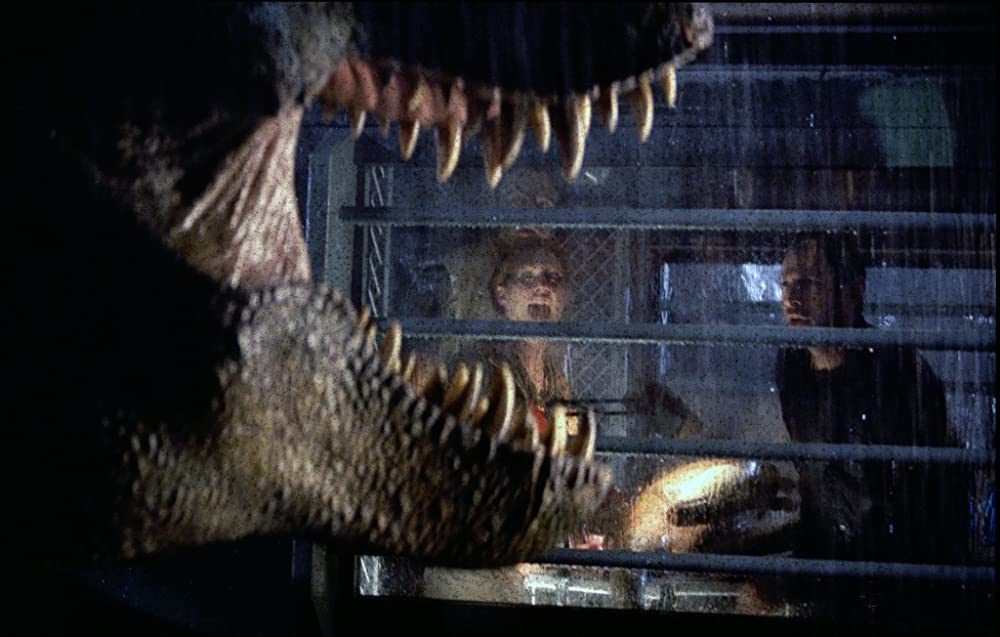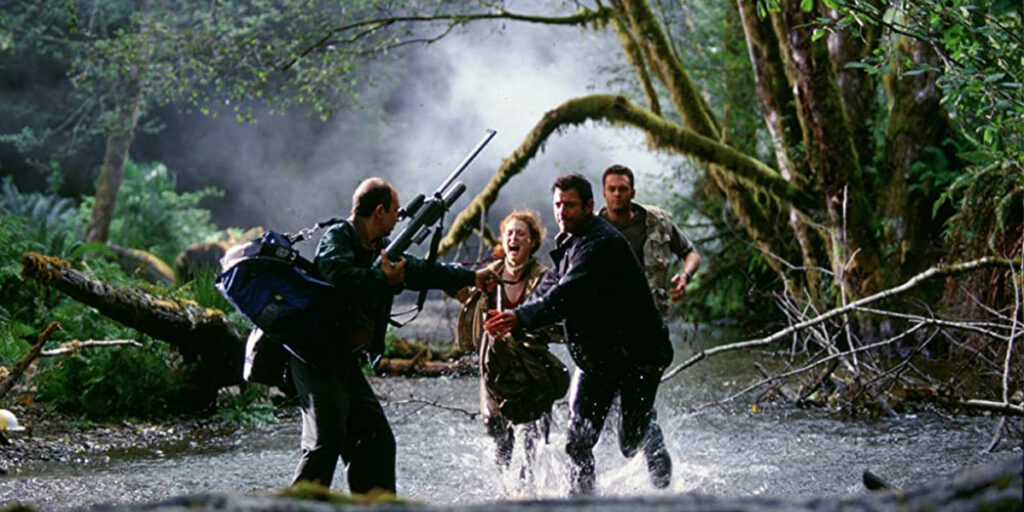Though it pales in comparison to its predecessor, The Lost World: Jurassic Park is an underrated sequel that takes the series in a darker direction.
What can you say about 1993’s Jurassic Park that everyone hasn’t already said? It’s one of the most popular and iconic films of all time, a revolutionary film for visual effects, and the birth of a franchise that’s still going to this day. But while it’s also one of my favorite movies, as well as my favorite Steven Spielberg movie, there’s nothing new left for me to say about it. Its first sequel The Lost World, on the other hand, is a film I have a bit more of a unique history with. I first saw it when I was around 10-12 years old or so, days after seeing and falling in love with the first Jurassic Park.
At the time, I thought it was fine, moderately entertaining enough, but it really didn’t leave any lasting impression on me. I went years barely even remembering it and not holding it in any high regard. But a couple of years ago, I decided to give it another go on a whim … and I found it to be a lot better than I remembered! The Lost World cannot even hope to touch the first film in terms of overall quality, but there are areas where it comes close in its own unique way, it continues the story in a believable manner, and it makes for an incredibly well-crafted and suspenseful dino thriller.
Directed again by Steven Spielberg, The Lost World opens up four years after the original Jurassic Park. In the wake of the fallout on the titular park’s main island, the park’s creator John Hammond (Richard Attenborough) reveals to scientist Ian Malcom (Jeff Goldblum) that there is another island where dinosaurs were initially created that has been abandoned, leaving the dinosaurs to run free in the wild. With Hammond’s nephew Ludlow (Arliss Howard) taking control of InGen and planning to bring the dinosaurs to a new park in the States, Malcom’s paleontologist girlfriend Sarah (Julianne Moore) has volunteered for a mission to study the creatures on the island to support an opposition to Ludlow. Malcom and a small crew venture off to retrieve Sarah, only to find themselves entangled with the efforts of Ludlow and running for their lives from the dangerous dinos that dominate the titular lost world.
For a sequel that didn’t really need to exist, this setup doesn’t feel like a total rehash in either concept or execution. It undoubtedly has similar sequences and beats, but it’s not just redoing the first Jurassic Park again. The Lost World focuses less on the ethical questions surrounding bringing these dinosaurs back in the first place, and more on the human responsibilities now that they are back. How should the aftermath be handled? Is it best to intervene for the sake of trying to aid them, or do we need to step aside as Hammond puts it? Do we have the right to study them like any other animal as enthusiastically as Sarah does, especially after decades of going solely off speculation and theory? Or is this a case where we just need to accept not getting all the answers even if they’re attainable?

Like in the first film, the draw of something so miraculous is shown as immensely powerful even within those with the best of intentions. Obviously the greed that drives Ludlow and his men is self-explanatory in how dangerous it is. But the interference of the “heroes” proves to have its own set of consequences. Though their drive to save the dinosaurs from abuse and captivity is admirable and relatable, their means of doing so more often than not make things even more chaotic and cause more lives to be lost in the destruction. The recurring trend of The Lost World is the danger of getting in the way without properly thinking things through, whether with good or ill will. Ultimately, in this film’s climax, the refusal to let two separate forces of nature remain separate leads them to collide in the most destructive way possible. It’s a very jarring climax in the best way and ups the ante without feeling like a completely separate franchise.
To further separate The Lost World from its predecessor, this sequel also goes for a very different style and tone. Jurassic Park is heavily filled with awe, wonder, and majestic buildup, which are fairly evenly interspersed with the darker and more suspenseful aspects of the story. The Lost World dials back that upbeat feel considerably in favor of a much moodier experience that plays more like a straight-up thriller than an adventure movie. There are no theme park aesthetics to dazzle the eye, there are far fewer grand or whimsical shots, a lot more of the film is set at night, and there are a few more prolonged sequences that play up the suspense and fear. This isn’t even unprecedented with Spielberg, as Indiana Jones and the Temple of Doom is similarly a notoriously darker and less “fun” sequel compared to its own predecessor.
Even those who don’t like this film admit that the sequence of two T-Rexes attacking the main team’s trailer is a major highlight. It’s an intense nail-biter that keeps finding creative ways to keep viewers on edge as everyone literally dangles by a thread. Another one of my favorite scenes is an extended pursuit by a Compsognathus pack that’s paced and shot like a scene in a slasher flick with the killer slowly wearing down its next victim. (And I can’t help but love the ability to make such tiny, cute critters one of the breakout threats of the movie.) You thought two raptors was scary in the first Jurassic Park? Try a pack of them stalking in the tall grass, taking down prey in an obscured but still visually frightening manner. The Lost World, from the halfway point to the end of the second act, almost serves as one massive chase sequence between the humans and various dinosaurs, one that was set up properly beforehand and therefore doesn’t feel like a hollow dino action movie just for the sake of it (unlike, say, Jurassic Park III).
And all of this is done while keeping true to the original Jurassic Park’s approach to the visual effects on the dinosaurs and sets: using CGI on wide shots of dinosaurs, while letting the animatronics and puppets take over for close-up shots and even a really impressive baby T-Rex. The stunts and props were also done in-camera as much as possible, which is crucial to the more aggressively dark nature of this film in particular. The dinos’ CGI is used more extensively here due to the higher frequency of shots that require it, and as such it’s not as consistent as the first movie, but a large majority of it is still fairly impressive. The hand of Spielberg ensures that Lost World can go toe-to-toe with its predecessor on a pure spectacle level, even if it’s not going for something as grand or epic.
Where Lost World unfortunately doesn’t manage to rival the first film is its cast of characters. No one here is outright badly written or totally uninteresting. Everyone has at least a couple of moments that make them a bit memorable. Sarah stands out for her bubbly enthusiasm and Moore’s energetic performance, and Pete Postlethwaite is an unexpected highlight as a big game hunter who begins to look inside himself and question his love of the dangerous life he yearns for. But everyone else is just fine. Even Malcom proves himself to work better as a supporting character than the lead, or he at the very least had meatier material in Jurassic Park.
The chemistry between these people is also surprisingly not that good. I don’t buy Malcom and Sarah as a genuine romantic couple, nor do I really buy Malcom as a father to his daughter (Vanessa Lee Chester) who stows away on board to the island. This group of characters is the only place where this sequel does feel like a run-of-the-mill dinosaur chase movie, even though every actor does their job perfectly well. This also causes the first act to drag a little bit while everyone is coming together and making their introductions prior to arriving on the island. I do, however, really like how characters are forced to go from sabotaging each other to working together and back again, blurring the lines of who we root for without bogging down the focus on the most important players. This isn’t a weak group of characters; it’s just not a particularly strong one.
But these shortcomings are certainly not enough to ruin The Lost World as a sequel to the iconic original or as a film on its own. Is it as good or groundbreaking as Jurassic Park? Definitely not. Are its characters remarkable overall? No. But this is still an expertly-crafted, exciting film that’s packed with amazing sequences that take this series to a different, less glamorous, and more frantic place while still staying true to the core of what made it enticing to begin with. And I can say that as someone who doesn’t have the years of nostalgic fondness that could create any sort of bias towards this movie. Nowadays, it’s very easy to feel the burnout of the Jurassic Park franchise with how often it’s resorted to a formula without pushing the envelope. But it’s far easier to digest certain repeated motifs here considering this is not only the first sequel, but a sequel that adds a good deal of creative new to go alongside the old. If you’ve had middling thoughts towards the film like I used to, give it another shot and see if it grows on you.
The Lost World: Jurassic Park was released on May 23, 1997.

